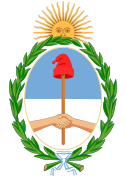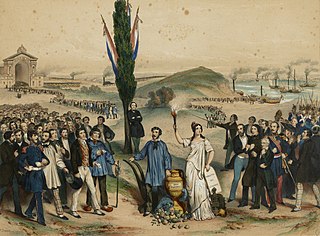
Mauricio Macri is the current President of Argentina and has been in office since 2015. A former civil engineer, Macri won the first presidential runoff ballotage in Argentina's history and is the first democratically-elected non-Radical or Peronist president since 1916. He was chief of government of Buenos Aires from 2007 to 2015, and represented the city in the lower house of the Congress of Argentina from 2005 to 2007. The reintegration of Argentina into the international community is central to Macri's agenda.

Daniel Osvaldo Scioli is an Argentine politician, sportsman, and businessman. He was the Vice President of Argentina from 2003 to 2007, under Néstor Kirchner, and was Governor of Buenos Aires Province from 2007 to 2015. He has also served two tenures as president of the Justicialist Party. He was the candidate to the presidency for the Front for Victory ticket in the 2015 general elections, and lost to Mauricio Macri in a runoff election.

Aníbal Domingo Fernández is an Argentine Justicialist Party politician, lawyer, and certified public accountant who has been a close ally, loyal to both, the late President Néstor Kirchner and the former President Cristina Fernández de Kirchner. He has held several cabinet positions under three presidents, serving in these offices for a total of over nine years. He served as Minister of Production under Eduardo Duhalde, as Interior Minister under Néstor Kirchner, as Minister of Justice under Cristina Fernández de Kirchner, and as the President's Cabinet Chief from 2009 to 2011.
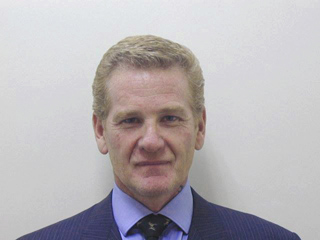
Francisco de Narváez Steuer, known as El Colorado or Pancho, is a Colombian-born naturalized Argentine businessman, politician who ran for governor of Buenos Aires Province on the PRO ballot in the 2007 elections in Argentina. He is currently a member of the Argentine Chamber of Deputies.

Legislative elections were held in Argentina for half the seats in the Chamber of Deputies and a third (24) of the seats in the Senate on 28 June 2009, as well as for the legislature of the City of Buenos Aires and other municipalities.

Marta Gabriela Michetti Illia is an Argentine politician, currently serving as Vice President of Argentina since 10 December 2015. Before her, the only woman to serve as Vice President of Argentina was Isabel Martínez de Perón.

Argentina held national presidential and legislative elections on Sunday, 23 October 2011. Incumbent president Cristina Fernández de Kirchner secured a second term in office after the Front for Victory won just over half of the seats in the National Congress.
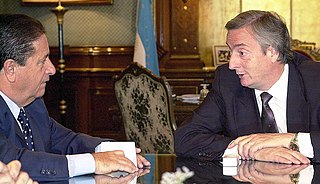
Federal Peronism, or Dissident Peronism, are the informal names given to a political alliance between Justicialist Party figures, currently identified mostly by its opposition to ruling Kirchnerism, the center-left faction that headed the national Government of Argentina from 2003 to 2015, and leads the Peronist movement.

María Eugenia Vidal is the current Governor of the province of Buenos Aires, being the first woman and the first non-Peronist since 1987 to be voted into office.

Broad Front UNEN was an Argentine political coalition that unites the Radical Civic Union, Civic Coalition ARI, Proyecto Sur, Freemen of the South Movement, Socialist Party, Authentic Socialist Party, and GEN. The name UNEN is an acronym of "Unión y Encuentro". Founded in April 2014, the purpose of the coalition was to unite the parties that oppose Peronism and Kirchnerism in a single entity, but the inclusion of the center-right party Republican Proposal was a controversial topic among the parties.
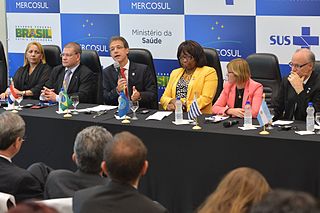
Daniel Gollán is the former Health Minister of Argentina.

Horacio Rodríguez Larreta is an Argentine politician and current Head of Government of the Autonomous City of Buenos Aires.
Cambiemos is an Argentine center-right big tent political coalition created in 2015. It is composed of the Republican Proposal (PRO), the Radical Civic Union (UCR), and the Civic Coalition (CC-ARI). These three parties respectively nominated Mauricio Macri, Ernesto Sanz, and Elisa Carrió as their representatives in the August 2015 primary elections, which were held to choose which candidate would run in the 2015 presidential election on 25 October. On 9 August 2015 Mauricio Macri was elected as the candidate who would represent Cambiemos in the presidential election; on 22 November he won the presidential election.

Several locations in the northern Buenos Aires Province suffered flash floods in August 2015, caused by a record rain. The Luján River, the Areco river and the Arrecifes River were the most affected. Three people died, and 11,000 had to evacuate their homes. The floods at the end of the Salado River neared 800,000 hectares.
Roberto Daniel Navarro is an Argentine journalist specialized at economy.

On the 25 October elections numerous provinces also elected governors, with the new ones beginning their terms on 10 December 2015. These provinces were Buenos Aires province, Catamarca, Chubut, Entre Ríos, Formosa, Jujuy, La Pampa, Misiones, San Juan, San Luis and Santa Cruz, encompassing 11 of the country's 23 provinces. The other provinces elected governors in different days of 2015; the only exceptions were Corrientes and Santiago del Estero whose governors' terms were not due to finish in 2015.

The Presidency of Mauricio Macri began on 10 December 2015, when Mauricio Macri was sworn into office on 10 December 2015 to a four-year term as President of Argentina. Macri took office following a 51.34% to 48.66% runoff ballotage win over Daniel Scioli in the 2015 general election. He is Argentina's first democratically-elected non-Radical or Peronist president since 1916.
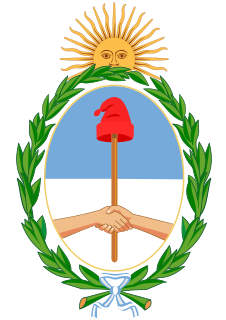
General elections will be held in Argentina on 27 October 2019, to elect the president of Argentina, members of the national congress and the governors of most provinces. Mauricio Macri is the sitting president, and will run for re-election.
The following lists events that will happen in Argentina in 2019.
